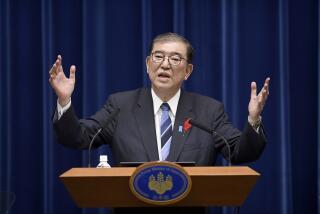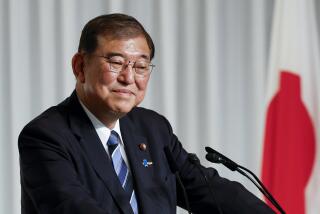Seemingly Inconceivable Scenarios Become Reality in Topsy-Turvy Japan : Politics: Three potential prime ministers are named to key posts in new Cabinet headed by Socialist Chairman Tomiichi Murayama.
TOKYO — What’s this? A party at the helm of Japan controlling only 14% of the seats in the lower house of Parliament? Radical left-wingers supporting a coalition with the old conservative stalwarts? Or, most unlikely of all, a Cabinet in which three potential prime ministers hold down the most important posts under a Socialist?
On Thursday, all three of those seemingly inconceivable scenarios became a reality in the topsy-turvy world of politics in Japan, which just a year ago was so stable that critics questioned if it really was a democracy. After all, what other democratic country had not experienced a change of government in 38 years?
Socialist Chairman Tomiichi Murayama, Japan’s new prime minister, served up the latest strange twists on Thursday when he named his Cabinet:
* Yohei Kono--who offered the nation’s top post to Murayama instead of seeking it himself as head of the largest party, the Liberal Democrats--was named foreign minister, with an additional title as deputy prime minister.
* Masayoshi Takemura, the leader of the New Party Harbinger who is viewed as a possible compromise prime minister in the future, became finance minister.
* And Ryutaro Hashimoto, a Liberal Democrat who voluntarily bowed to Kono last August when the LDP chose a new leader, was named minister of international trade and industry.
All three men differ from their back-bench predecessors in bringing both personal power and a reputation for making their own decisions to their posts. They also have vowed to end the rubber-stamping of decisions made by bureaucrats that pervaded the “reform” coalition administrations of Morihiro Hosokawa and Tsutomu Hata.
Takemura, for one, on Wednesday overturned a Hata Cabinet acceptance of a Finance Ministry proposal that would have turned a plan to cut income taxes to spur the economy into a program for a net tax increase in the future.
“Rather than fly off the bat into a decision fixing increases in the (3%) consumption tax, first we have to study how much costs can be cut by reforming the government’s administration, just like private enterprises are doing as they carry out restructuring,” he said. “After that, we can figure out how much more revenue is needed” to replace the shortfall from income-tax cuts.
He also refused to set any deadline for a decision, defying the budget-balancing-obsessed Finance Ministry. The ministry wants legislation by the year’s end to impose a consumption tax increase three years from now.
Although Murayama noted that he had been chosen in “uncommon fashion” and said he wants to implement “uncommon politics,” his Cabinet--except for the appointments of the three bigwigs--was not uncommon. Seats were apportioned by seniority and factional affiliation in line with the strengths of the coalition--13 to the Liberal Democrats, five to the Socialists and two to the New Party Harbinger.
Only one woman, Makiko Tanaka, the outspoken daughter of the late Prime Minister Kakuei Tanaka, was appointed. She became minister of science and technology.
Man-in-the-street interviews aired on television showed apprehension about a government headed by a party once noted for its “opposition for opposition’s sake” approach to politics. Many predicted that Murayama, like his six predecessors in the last five years, would not last long. “Do something to improve the economy” was the most widespread request made of the new government.
The emergence of the “odd-triangle” Cabinet itself underscored the upheaval that has altered the old assumptions of Japanese politics.
Japan’s own miniature version of the Cold War--the Liberal Democrats on America’s side, the Socialists often on communism’s side--ended when the United States and Russia shook hands.
Despite their official advocacy of abolishing the U.S.-Japan Security Treaty, the Socialists, for example, haven’t said a word in years about getting rid of the alliance and the bases it provides to the United States in Japan.
The Liberal Democrats, in their party charter, advocate constitutional revision--which is anathema to the Socialists. Yet the LDP has done nothing for decades to press for revision.
Last summer, defections of about 50 legislators broke the LDP grip on government, wiping out the old definitions of political divisions between “conservatives,” who ran the government, and “progressive reformists,” who bided their time in the opposition.
For the first time, conservatives supporting Hosokawa, then Hata, suddenly became the “progressive reformists.” The Socialists, who lost nearly half their seats in an election last July, were the big losers--not the Liberal Democrats, who actually gained one seat compared with their post-rebellion holdings going into the election.
Even the old barometers of party seats in Parliament and the size of factions of legislators run by political bosses have become tenuous measuring sticks in attempts to predict the future.
The Socialists, for example, head the government holding only 14% of the seats in the lower house. Even how much support Murayama’s Cabinet has in Parliament is unknown. On paper, parties backing him should have produced 301 votes in Wednesday’s election. Yet Murayama polled only 261 in a runoff.
Party discipline is cracking. Rebellions remain fermenting. And more realignments are likely as Japan seeks a new basis on which to deal with new issues.
Should big government finance welfare costs for an aging population--or should more self-reliance be sought? Should government, through the standards it sets, continue to ensure consumer product safety, or should consumers assume the responsibility themselves? Does Japan wish to play a greater international role, or remain a passive bystander in global politics?
More fundamentally, will Japan continue to rely upon agonizingly slow consensus-making (as Murayama’s Cabinet appears to favor), or should votes be taken and majority decisions enforced (as Ichiro Ozawa, Hata’s chief strategist, argues)?
Now that Japan has suddenly become a nation of coalition governments after knowing nothing but rule by the Liberal Democratic Party from 1955 to 1993, the answers, with few exceptions, can no longer be found within party structures, or even within party factions. In that sense, Murayama’s coalition is not unique.
The Liberal Democrats and Socialists already have far more experience in dealing with each other than most people remember. During the long LDP rule, the two parties cooperated so that bills the Socialists opposed, or pretended to oppose, were enacted. Even scuffles and pushing matches were scripted, said Yasuhiro Tase, a senior political reporter for the Nihon Keizai newspaper. Murayama himself once served as his party’s parliamentary steering committee chief, and won a reputation for smooth dealings with the Liberal Democrats.
Indeed, a bitter Hosokawa, whom the Liberal Democrats forced to resign in April over charges of questionable financial dealings, condemned the new coalition as yet another “act of collusion” between the two groups. He predicted it would be their last “conspiracy.”
Murayama and Kono, however, asked voters to wait and see.
Leaving home Thursday, Murayama said he would try to ease “feelings of uneasiness” that his election had caused “in various circles.” Kono challenged reporters to examine the new coalition’s policies “to see if we really have trouble reaching agreement” on what to do and watch to see “if we really are an ‘illicit union,’ as critics charge.”
More to Read
Sign up for Essential California
The most important California stories and recommendations in your inbox every morning.
You may occasionally receive promotional content from the Los Angeles Times.










